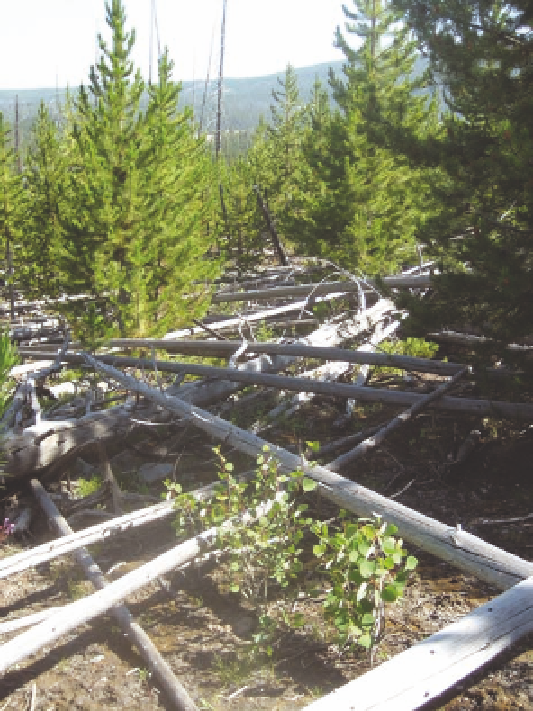Geoscience Reference
In-Depth Information
fire rotation probably could not occur. nevertheless, the
important message of this study is that fire will almost
certainly become more frequent in the future. With a
substantially shorter fire rotation, the older forests that
now characterize much of the GYe could not persist in
their present form. Moreover, post-fire vegetation devel-
opment could be very different from the smooth recov-
ery that occurred after 1988 if the climate is no longer
ling and his associates emphasized that there are many
uncertainties, but substantial changes in vegetation pat-
terns appear likely.
Beetles, Blister Rust, Whitebark Pine, and Grizzlies
Whitebark pine is common at the highest elevations in
the GYe and northern Rockies, where it stabilizes soils
and provides abundant seeds that are an important
food for grizzly bears and other wildlife. Recent fires
have burned whitebark pine forests, but this species is
capable of recovering from fire via seeds transported
may not recover from are the combined effects of global
climate change, mountain pine beetles, and a non-
native invasive pathogen—the white pine blister rust
(see chapter 14). Warming has allowed mountain pine
beetles to expand upward into whitebark pine forests
(see chapter 11 for beetle biology). only recently have
entomologists learned that this pine lacks most of the
chemical defenses against bark beetles that are found
in lodgepole pine, most likely because the cold climate
in whitebark pine's high-elevation habitat formerly lim-
ited bark beetle development and survival. When out-
breaks did occur in the past, they were infrequent and
brief. However, the warm temperatures of the past 20
years have allowed mountain pine beetles to success-
fully attack whitebark pine over large areas; mortality of
the beetles generally have not killed the smaller
whitebark pine trees because, instinctively, the insects
fly toward the larger trees that have adequate phloem
to sustain a brood of beetle larvae. ordinarily one
would expect whitebark pine forests to recover from
the beetle outbreak through growth of the smaller sur-
vivors. However, the white pine blister rust, a fungus
native to eurasia that was accidentally introduced to
north America around 1900, kills whitebark pine trees
Fig. 15.16. the small aspen in the foreground of this photo,
taken near old Faithful, became established from seed after
the 1988 Yellowstone fires. these young aspen have been
heavily browsed by ungulates, but some have established new
clones in the area. the lodgepole pine in this photo are about
20 years old. the downed wood is from the trees killed by the
1988 fires.
large fires and warm summers in the Rockies from 1972
to 1999; they then applied this relationship to predict
fires for the next century, using four different global
about 2050, large fires could be occurring almost every
year, and the fire rotation in most of the GYe could be
reduced from the historical rotation of 120-300 years
to less than 20 years. Fire rotation is a standard measure
of fire frequency and is defined as the number of years
required for cumulative area burned to equal the size
of the entire area of interest. this modeling procedure
did not include changes in fuels; it assumed that fuels
would always be sufficient to permit burning even at
very short intervals. However, fires would begin to be
limited by fuel availability as intervals between fires
became ever shorter; the researchers noted that a 20-year

Search WWH ::

Custom Search